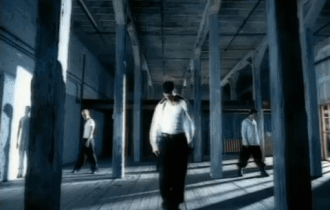Released: 1st September 1997
Re-release: 14th June 1999
Writers: Kristian Lundin / Max Martin
Peak position: #9
Chart run: 40-61
Chart run (1999): 9-14-20-25-34-51-57-64-X-X-X-74-73
Billboard Hot 100 chart run: 59
Although *NSYNC launched in the UK in 1997, it was almost two years before they scored their first top ten hit. Tearin’ Up My Heart would – eventually – become their second. But the first time around, it didn’t fare so well.

The track was *NSYNC’s introductory single here, although it wasn’t their proper debut because I Want You Back had already been released in Germany the previous year. There is – perhaps – some logic to the decision to switch the tracks around, since Tearin’ Up My Heart had proven to be a bigger success. Although as it happens neither song was a hit first time around in the UK anyway. When the group was re-launched in 1999, they led with I Want You Back instead, and this became the follow-up single once more.

We got only a snapshot of the pre-No Strings Attached *NSYNC in the UK, so both of their early singles have always seemed a bit out of place in the context of their career in its entirety. There is no getting around the fact that this sounds like a Backstreet Boys song – in fact, it almost was – but the two groups were on rival labels, so for BMG to use the same songwriting and production team as their competition was as smart as it was necessary. It does mean that Tearin’ Up My Heart lacks the distinctive identity of *NSYNC’s later material, although equally, the fact that it makes such a good attempt at emulating the Backstreet Boys’ means it’s still a very good pop song.

The track opens with a dramatic rendition of the chorus before the bassline kicks in. This is classic early-Cheiron at the time, complete with that recognisable halcyon twinkling sound effect. Tearin’ Up My Heart is quick to establish the familiar dynamic of JC Chasez and Justin Timberlake on lead vocals; in that sense, there’s slightly less emphasis on stacking harmonies into the song. They are there, but rarely – if ever – to such an extent that you get a sense of what *NSYNC sound like when they’re all singing together at equal volume.

The benefit of that approach to Tearin’ Up My Heart is that it creates measurable investment in the verses. The group were cutting their teeth as a boyband; thus, their performance is everything that torrid, tormented teen-pop demanded. The pre-chorus: “Let it GO, if you want me girl, let me KNOW, I am DOWN on my KNEES, I can’t take it any-MORE” is appropriately angst-ridden, and while *NSYNC were yet to grow into their voices fully, the track nevertheless gives a clear indication of how they would do so. You can hear a spiky growl developing in JC’s tone, while Justin Timberlake – in his mid-teens at the time Tearin’ Up My Heart was recorded – sings with a more noticeable Southern-twang. Without the deepness to his lower register that would come with age, he sounds every bit the lovelorn, doe-eyed adolescent. Little surprise then that he would rapidly become the heartthrob of the group.

Even though the single enjoyed most of its success towards the end of the ’90s, it was a mid-decade composition, and that occasionally shows. The production is delightfully bouncy, with its squelchy synths and – of course – the dramatic middle-eight where the bottom drops out of the music. But the hooks still feel a little rough around the edges and are compensated by the emphatic arrangement of the vocals as a result: “It’s tearin’ up my HEART when I’m with you, but when we are a-PART, I feel it TOO, and no matter what I do, I feel the pa-ai-ain, with or without you”. Tearin’ Up My Heart is never anything less than incredibly catchy, but it doesn’t quite muster the sort of earworm that reaches right down inside you. Again, it’s a testament to what both *NSYNC and Cheiron were capable of that a song this good doesn’t come to their top-tier efforts.

The music video for Tearin’ Up My Heart is very much a rite of passage for any ’90s boyband during their initiation to the charts, to such an extent that any attempt to deduce a meaningful narrative is pointless. We’re in postmodern video-within-a-video territory here, which is as much an opportunity for the group to showcase their emoting skills as it is to have Justin Timberlake writhing around on a bed in his vest. The real aim, though, is to start establishing *NSYNC’s personality; in-between the professional shots, we see them goofing around and doing all the stereotypical things that American teen boys did in the mid-’90s: play basketball, hit punching bags and lift weights. By the time the track was re-released in 1999 (with the same video), the group looked quite different. But that just ensured the leap they made with their next album – now less than 12 months away – all the more striking.

Upon its original release in 1997, Tearin’ Up My Heart peaked at #40 in the UK; it was swiftly followed up by I Want You Back, which fared even worse, reaching #62. And that could so easily have been it for *NSYNC, particularly because it came at a time when the Backstreet Boys had asserted their legacy with Everybody (Backstreet’s Back). But the group continued plugging away across America and Europe, slowly growing their profile. In total, seven singles were released from their debut album, which makes all the more amusing that we only got two of them. Twice! However, by the time Tearin’ Up My Heart reappeared in 1999 – this time peaking at #9 – *NSYNC were on the cusp of an acrimonious split from their former manager Lou Pearlman and record label BMG. At the time, it may have seemed to the group that their breakthrough had come at an inopportune moment, but life has a funny way of working out.

*NSYNC experienced the dark side of the music industry long before any of their peers; it became a defining part of their identity, changing them in the process. They came through it a different – and slightly jaded – act altogether, consequently moving with more urgency than their rivals. In the UK, at least, Tearin’ Up My Heart marks the end of *NSYNC’s formative phase; things were never really this functional and uncomplicated again.



